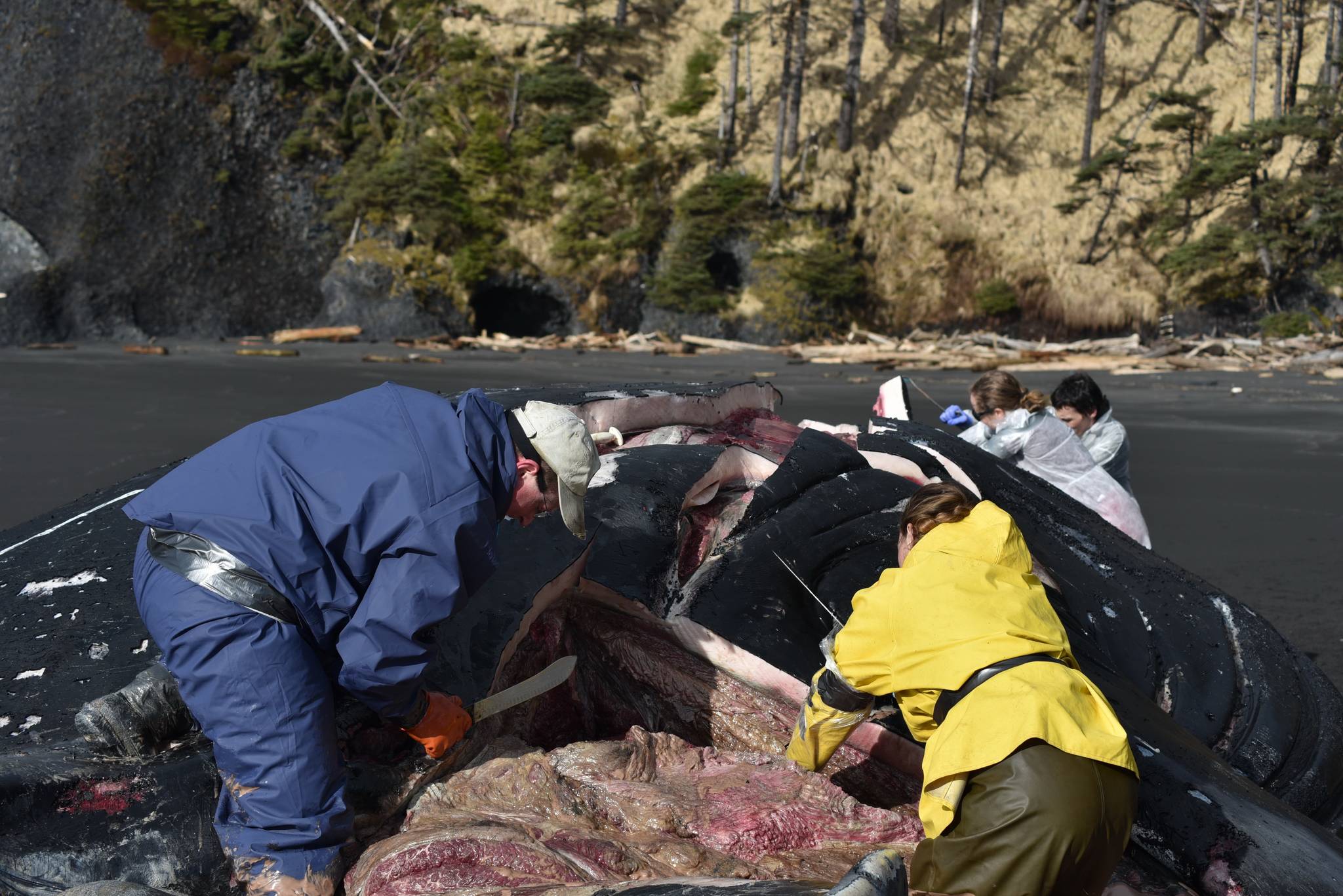A well-placed whale carcass and a break in the weather gave volunteers in Sitka a rare opportunity to conduct a necropsy on a beached humpback whale last week.
Volunteers with the Alaska Marine Mammal Stranding Network collected samples from a whale that washed up at the southern end of Kruzof Island after the carcass was reported by the U.S. Coast Guard.
The volunteer teams were led by scientists from the University of Alaska Southeast’s Sitka campus, the university said in a news release, and provided the chance to access and study a fresh whale carcass.
The U.S. Coast Guard reported the carcass to the National Oceanic and Atmospheric Administration Fisheries Stranding Network on March 14, which relayed the information to the Alaska network. Two volunteers were able to reach the whale that afternoon, according to a news release from the University of Alaska Southeast. Weather forced them to retreat, but the team, Ellen Chenoweth and drone-operator Joshua Houston, were able to take images of the whale, the release said.
A necropsy team was put together and on March 18, the Coast Guard in Sitka helicoptered six volunteers to the beach while others came by boat. One of the team members helicoptered to the site was Lauren Wild, a fisheries technology professor at UAS in Sitka.
“It’s unusual to have (a carcass) as fresh as it was,” Wild told the Empire in an interview. “Fresh dead animals and having them wash up is what we like.”
[Mask rules standoff derails House floor session]
The team used the opportunity to collect samples and study parts of the whale before they decomposed too much, Wild said. It’s not often that fresh whale corpses wash up on easily accessible beaches, she said, and fresh carcasses can provide a lot of information.
Samples from this whale — a 47-foot female — are still being analyzed she said, and it’s not yet clear what exactly killed the whale. The stomach was mostly full indicating the whale had eaten recently, ruling out starvation, and there didn’t appear to be any signs of disease in the organs, she said.
But a storm did come through before the volunteers were able to reach the whale, and the elements had deteriorated parts of the body, namely the head area, Wild said.
“It was sort of a brain and tongue soup in the head region,” she said.
The whale didn’t appear the have been hit by a boat or propeller, but the decomposition means there are things the team missed, Wild said. Humpback whales migrate between Alaska and Hawaii, Wild said, but they only feed in Alaska. At this time of year when the whales are returning from that migration, it’s not uncommon to see whales die from starvation, she said, but that didn’t appear to be the case here.
The drone operator was able to capture images of the animal’s tail, or fluke, which is how scientists identify individual whales. So far this whale’s fluke hasn’t matched any in the NOAA database, Wild said, but the team hadn’t given up hope.
Interestingly, Wild said, this particular whale had on its fins “rabbit-ear barnacles,” which she said only grow on other barnacles that themselves only grow on humpback whales. Tissue samples were collected from the lungs, heart, liver, stomach, and other organs and sent to the Alaska Veterinary Pathology Services and Kathy Burek for histology and pathology analysis, according to UAS.
Wild said while necropsies on whale carcasses are great opportunities to collect information, they’re also difficult to coordinate and rely solely on volunteers. The stranding network itself is a NOAA operation, but relies on coordination between federal, state and local authorities, she said, many of them volunteers.
Wild said if anyone sees a floating or stranded marine mammal, alive or dead, they should call the network at 877-925-7773.
Contact reporter Peter Segall at psegall@juneauempire.com. Follow him on Twitter at @SegallJnuEmpire.

